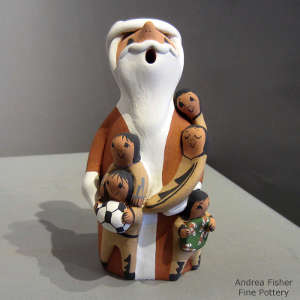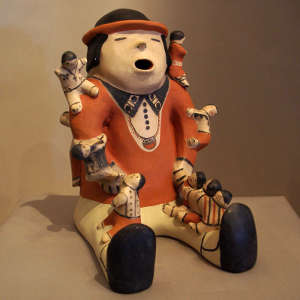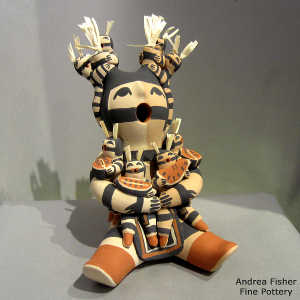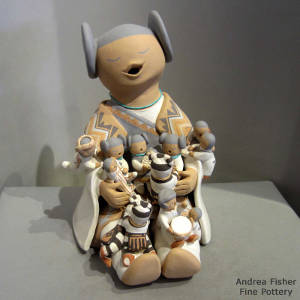Shapes and Forms: Storytellers
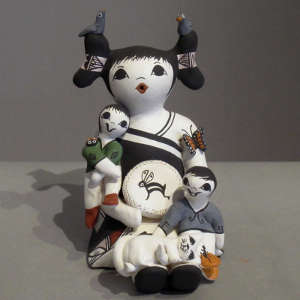
Grandmother storyteller with birds, cat, two children, lady bug, butterfly and Mimbres designs
Judy Lewis, Acoma
4 in H by 3 in Dia
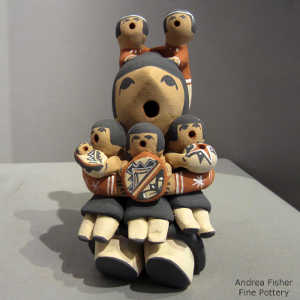
Grandmother storyteller with 2 children on her head and 4 more in her lap
Judy Toya, Jemez
6.5 in H by 4.25 in Dia
Clay figures have been present in New World pottery for thousands of years. Pottery figures of animals and humans have been found near Valdivia, Ecuador and were dated to about 3,500 years before the present. Fast forward to today and there's a whole universe of effigies and figures in the Native American pottery world. However, there was a time not long ago when the making of figures was banned and the makers were punished. That time was during the European invasion, specifically the Spanish invasion during the Spanish Inquisition. While a significant number of crypto-Jews were in that mass of Spaniards, there were also many Franciscan monks who systemmatically set about destroying all traces of indigenous history, language and religion. The Puebloans just went underground with their religion and languages and kept telling their oral histories to their children, who grew up and repeated those same stories to their children. Eventually the people had more than enough and the situation blew up militarily: those Spaniards and monks who weren't outright killed where they were found were chased back to Chihuahua.
The Pueblo Revolt of 1680 was somewhat successful but the Spaniards kept coming back and assaulting the more southern pueblos along the Rio Grande. Then they would loot what they could and burn the place down. Then in 1692 the Spanish came back and stayed. By 1696 they had either conquered the pueblos or the pueblos had capitulated.
Things were different this time as the Franciscans were replaced with a kinder group of Jesuits and those monks were not allowed to enslave the local populations to build greater and greater missions for the glory of a God that seemed to so horribly discriminate against the people. Puebloan religion, languages and oral histories were not a target so much for destruction with the Jesuits, and they were allowed to survive underground.
At the same time, there were masses of people from almost every pueblo who fled to the Hopi mesas after 1692. Spanish monks and officials visited Hopi now and then but their military never really went there.
The Hopi mesas after the Pueblo Revolt were an area of intense cross-pollination of ideas, designs and techniques for the making of pottery. Then the village of Awatovi (on Antelope Mesa to the east of First Mesa) was destroyed, primarily because that was the only village in the Tusayan area where a full-size Christian mission was actually built and completed. That was in 1700 CE, and except for a few ritual specialists, the entire pueblo was destroyed with most residents being burned to death in that destruction. That was also when many Tewas from the Galisteo Basin area and upper Rio Grande were recruited by the Hopi to come there and help to protect the Hopi pueblos from future Spanish incursions and from marauding Utes and Dineh.
By the time the railroads arrived, pueblo potters were back in business, although on a lesser scale as the use of utilitarian pottery dropped off when traders with enamel cookware came through in the mid-1800s and pottery as art hadn't happened yet. The railroads changed that as traders from the railroad companies went into some of the pueblos and "pre-ordered" specific types of pottery they could resell as tourist trinkets. That opened up a period of higher and higher production of progressively lesser and lesser quality pottery until they finally destroyed their market.
In the pueblos most involved in that business, pottery production dropped off to only what was needed for ceremonial or utilitarian purposes. As other pottery-producing pueblos missed that trainwreck and were beginning to develop a market with pottery-as-art, those hit hardest by the railroad traders began to adapt their products and develop their own art market, too. Some potters were lucky in that they were able to attract investors, traders who saw the value in helping individual artists develop their craft. One of those investors was an art dealer from Albuquerque named Alexander Girard. And he invested in Helen Cordero of Cochiti Pueblo.

Coyote wearing a winter shawl with six children, by Snowflake Flower, Cochiti
8.5 in H by 5.75 in Dia
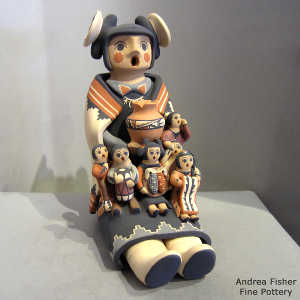
Grandmother storyteller with squash blossom hairdo and six children, by Linda Lucero Fragua, Jemez
9.5 in H by 8 in Dia
In 1964 Helen produced the first storyteller figure. She'd been making pottery since the mid-1950s but hadn't been happy with the usual plates, jars and bowls she made. Then her cousin suggested she make figures instead. She said she felt like something bloomed inside her with that.
Cochiti Pueblo has a long history of making figures and Helen was innovative with her creations. That's what attracted Alexander Girard to her. He offered to buy everything she made but he also encouraged her to branch out and experiment with building larger and more complex figures.
One of the traditional forms at Cochiti was the "Singing Mother," a seated figure holding a child. Helen was working at creating a Singing Mother that she would be happy with but she says she kept seeing her grandfather's figure in her mind as she worked. Her grandfather was a "storyteller," an elder of the tribe who carried part of the tribe's oral history. He passed that oral history down to the children by singing the stories in his native tongue. And he usually had numbers of children around him when he sang.
In honor of him she built the first storyteller. To her, the figure needed to be male as men were usually the keepers of the oral history. And the best way to show the reason for a "storyteller" was to also attach figures of children to him (or her). So she built her first one in honor of her grandfather and she perched a bunch of kids on him. She named it "Storyteller." That first storyteller made history. It's also on display as part of the Alexander Girard Collection at the Museum of Indian Artifacts and Culture on Museum Hill in Santa Fe, NM.
Today, as many as 300 potters spread across 13 pueblos have adapted that original idea to their own tribe's perspective and created storyteller figures of their own. And many of those figures are not men or women but bears, birds, Santa's, mudheads, owls, koshares... all different sizes and shapes... and some of them have more than 100 children attached to them.

Eight children on a raccoon storyteller, by Margaret and Luther Gutierrez, Santa Clara
5.25 in H by 4.75 in Dia

Grandmother storyteller figure with eight children, earned a 3rd Place ribbon in 1981 at the New Mexico State Fair, by Ada Suina, Cochiti
8.5 in H by 9.75 in Dia

Grandmother storyteller wearing a manta with two children and a puppy, by Emily Fragua Tsosie, Jemez
6.5 in H by 4.5 in Dia
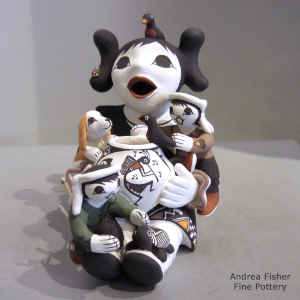
A grandmother storyteller with 2 children, puppy, birds, turtle and geometric design, by Marilyn Ray, Acoma
5.75 in H by 5 in Dia
